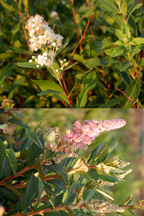Wild native shrub suitable for home landscape plantings
August 20, 2012
 |
|
Spiraea alba (at
top) and Spiraea tomentosa, two
species related to a popular landscaping plant, could offer new options for
gardeners. |
WEST LAFAYETTE, Ind. - Hoping for an alternative to the common landscaping plant Japanese Spirea, Purdue University scientist Mike Mickelbart found that it's possible to bring the plant's native cousins into backyards.
Mickelbart, an associate professor of horticulture, has filled his yard with native plant species. Spiraea japonica, a shrub also known as Japanese Spirea that typically has pink flowers, is one of the most common landscape native species available at nurseries, but Mickelbart has never been attracted to it.
"Planting natives in my backyard is a fun way to learn about the native flora," Mickelbart said. "I see a lot of Spiraea japonica and day lilies. But I would like to see the palette of native plants available for landscape use expand."
Spiraea alba, a shrub with white flowers, and Spiraea tomentosa, a shrub with pink flowers, are native to much of the Midwest and Northeast in the United States. But the acidic soils the shrubs are used to in their wild habitats were seen as limiting factors in adapting the plants to urban Midwestern landscapes, which typically have neutral to alkaline soils.
Mickelbart grew the plants over two years in a range of soil pH levels - from the acidic soil the plants are used to in the wild, to a neutral soil common in home flower beds. The neutral soil pH levels resulted in slightly smaller plants than would be found in natural settings, but leaf greenness and leaf size were unaffected.
 |
|
Mike Mickelbart |
"These are underutilized native plants," said Mickelbart, whose findings were reported in the July issue of the journal HortScience. "This shows that they could be incorporated into our landscaping. They might be a little smaller, but they should do just fine."
The drawback, Mickelbart said, is that local nurseries don't currently carry Spiraea alba and Spiraea tomentosa. He said that anyone interested should look to online seed or plant dealers, or ask a local nursery if they can obtain plants.
"These plants are not out there yet, but if demand grows, nurseries might start carrying them," Mickelbart said.
Wildtype Nursery, Possibility Place Nursery and Greendell Mulch donated materials, and the Indiana Nursery and Landscape Association partially funded the research.
Writer: Brian Wallheimer, 765-496-2050, bwallhei@purdue.edu
Source: Mike Mickelbart, 765-494-7902, mickelbart@purdue.edu
ABSTRACT
Soil pH Effects on Growth and Foliar Nutrient Concentrations of Spiraea alba Du Roi and Spiraea tomentosa L.
Michael V. Mickelbart, Michael J. Gosney, James Camberato and Kelly M. Stanton
The North American native plants Spiraea alba and S. tomentosa have potential as landscape plants because they are small- to medium-sized shrubs with showy flowers that persist from early to late summer. However, the cultural requirements of these species are not well documented. Both species grow in slightly acidic soils in their native habitats. The objective of this work was to determine if the growth and/or appearance of these shrubs is affected by the neutral to slightly alkaline soils common throughout the Midwest. Spiraea alba grown from three seed sources and S. tomentosa grown from a single seed source were grown for 2 years in soils of different pH. Elemental sulfur (S) was incorporated into a Drummer silty clay loam with a pH of 7.2 to bring the pH to 5.8 and 6.4 2 years after incorporation, thus establishing plots with three pH levels for assessing growth and appearance. The soil pH increased to 6.4 and 6.8 in the amended plots between Years 2 and 3 after S incorporation. Soil concentrations of exchangeable magnesium (Mg) and calcium (Ca) were lowered with added S. Height and width varied among S. alba from different seed sources, and height and width of all plants were reduced when grown at the highest soil pH. Leaf greenness, specific leaf weight, and individual leaf area were unaffected by pH. Leaf concentrations of nitrogen, potassium, zinc, and manganese were higher in lower soil pH, whereas Mg was lowest at the lowest soil pH. These results suggest that S. alba and S. tomentosa can be grown in neutral pH soils without an effect on plant appearance, but plant size will be less than at pH levels closer to the native soils for these species. Although some micronutrients were present at lower concentrations at the neutral pH, leaf greenness was unaffected, again suggesting that these plants may perform suitably outside of their native habitat pH range.
Ag Communications: (765) 494-2722;
Keith Robinson, robins89@purdue.edu
Agriculture News Page

